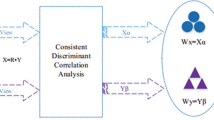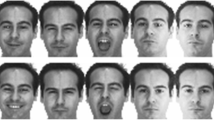Abstract
In high dimensional data analysis, canonical correlation analysis (CCA) mainly studies the linear correlation between two sets of features and it is an effective two-view feature extraction method. However, CCA cannot extract the features that are invariant under some transforms. Moreover, CCA is an unsupervised learning algorithm which does not contain the class label information. These limits the classification performance to some extent. In this paper, a novel learning algorithm is proposed, called supervised CCA based on partial differential equations (SCCA-PDEs), which considers both invariance of the features under some transforms and discriminative. More concretely, SCCA-PDEs firstly extracts the feature matrix of each view by using the evolutionary process of PDEs; and then the between-class and within-class scatter matrices are introduced into the criterion function to enhance the discriminative power of features, which results in not only maximizing the correlation between two feature vectors, but also maximizing between-class separability and simultaneously minimizing within-class cohesiveness; and next fuse the extracted features by two given fusion strategy to form discriminative feature vectors for classification tasks. The experimental results on several benchmark databases show that SCCA-PDEs has better discriminating power and robustness than the existing related algorithms.












Similar content being viewed by others
References
Alilou VK, Yaghmaee F (2017) Non-texture image inpainting using histogram of oriented gradients. J. Vis. Commun. Image R. 48:43–53
Al-Tayyan A, Assaleh K, Shanableh T (2017) Decision-level fusion for single-view gait recognition with various carrying and clothing conditions. Image Vision Comput. 61:54–69
Andrew G, Arora R, Bilmes J, Livescu K (2013) Deep canonical correlation analysis, In: Proceedings of the 30th international conference on machine learning (ICML). Atlanta, Georgis, pp 1247–1255
Apatean A, Rogozan A, Bensrhair A (2016) Image Features Extraction, Selection and Fusion for Computer Vision. In: Awad A, Hassaballah M (eds) Image feature detectors and descriptors: foundations and applications. Studies in computational intelligence. vol 630. Springer, pp 75–107
Belhumeur PN, Hespanha JP, Kriegman DJ (1997) Eigenfaces vs. Fisherfaces: Recognition using class specific linear projection. IEEE Trans. Pattern Anal. Mach. Intell. 19(7):711–720
Bruna J, Mallat S (2013) Invariant scattering convolution networks. IEEE Trans. Pattern Anal. Mach. Intell. 35(8):1872–1886
Chen J, Wang G, Shen Y, Giannakis GB (2018) Canonical correlation analysis of datasets with a common source graph. IEEE Trans. Signal Process. 66(16):4398–4408
Cheveigne A, Liberto G, Arzounian D et al (2019) Multiway canonical correlation analysis of brain data. NeuroImage 186:728–740
Constantinidis AS, Fairhurst MC, Rahman AFR (2001) A new multi-expert decision combination algorithm and its application to the detection of circumscribed masses in digital mammograms. Pattern Recognit. 34(8):1528–1537
Cui Y, Fan LY (2012) A novel supervised dimensionality reduction algorithm: Graph-based Fisher analysis. Pattern Recogn. 45:1471–1481
Du L, Huang H et al (2016) Structured sparse canonical correlation analysis for brain imaging genetics: an improved GraphNet method. Bioinformatics 32(10):1544–1551
Elmadany NED, He Y, Guan L (2018) Information fusion for human action recognition via biset/multiset globality locality preserving canonical correlation analysis. IEEE Trans. Image Process. 27(11):5275–5287
Fang C, Zhao Z, Zhao P, Lin Z (2017) Feature learning via partial differential equation with applications to face recognition. Pattern Recogn. 69:14–25
Fu Y, Cao LL, Guo GD, Huang TS (2008) Multiple feature fusion by sub-space learning. In: Proc. int. conf. image & video retri. niagara Falls, pp 127–134
Gao X, Sun QS, Yang J (2018) MRCCA: A novel CCA based method and its application in feature extraction and fusion for matrix data. Appl. Soft Comput. 62:45–56
Hotelling H (1936) Relations between two sets of variates. Biometrika 28(34):321–377
Hou SD, Sun QS (2012) Sparsity Preserving Canonical Correlation Analysis with Application in Feature Fusion. Acta Automatica Sinica 38(4):659–665
Jin XY, Zhang D, Yang JY (2003) Face recognition based on a group decision-making combination approach. Pattern Recognit. 36(7):1675–1678
Kumari P, Vaish A (2016) Feature-level fusion of mental tsak’s brain signal for an efficient identification system. Neural Comput. Applic. 27(3):659–669
Lee K-C, Ho J, Kriegman D (2005) Acquiring linear subspaces for face recognition under variable lighting. IEEE Trans. Pattern Analy. Mach. Intell. 27(5):684–698
Lenc L, Kral P (2015) Automatic face recognition system based on the SIFT features. Comput. Electr. Eng. 46:256–272
Leng L, Teoh ABJ (2015) Alignment-free row-co-occurrence cancelable palmprint fuzzy vault. Pattern Recogn. 48(7):2290–2303
Leng L, Li M, Kim C et al (2017) Dual-source discrimination power analysis for multi-instance contactless palmprint recognition. Multimed. Tools Appl. 76:333–354
Li Y, Deng S, Zou BZ (2020) Using feature fusion strategies in continuous authentication on smartphones. IEEE Internet Comput. 24(2):49–56
Li H, Hua G, (2015) Hierarchical-PEP model for real-world face recognition, In: Proceedings of the IEEE conference on computer vision and pattern recognition (CVPR). Boston, Massachusetts, pp 4055–4064
Liu CJ, Wechsler H (2001) A shape and texture-based enhanced fisher classifier for face recognition. IEEE Trans. Image Process. 10:598–608
Liu R, Lin Z, Zhang W, Tang K, Su Z (2013) Toward designing intelligent PDEs for computer vision: an optimal control approach. Image Vis. Comput. 31(1):43–56
Liu R, Lin Z, Zhang W, Su Z (2010) Learning PDEs for image restoration via optimal control. In: Proceedings of the european conference on computer vision, Springer, pp 115-128
Melzer T, Reiter M, Bischof H (2003) Appearance models based on kernel canonical correlation analysis. Pattern Recogn. 36(9):1961–1971
Peng J, Li Q, Abd El-Latif AA, Niu X (2015) Linear discriminant multi-set canonical correlations analysis (LDMCCA): an efficient approach for feature fusion of finger biometrics. Multimed. Tools Appl. 74:4469–4486
Qin Y, Bruzzone L, Li B, Ye Y (2019) Cross-domain collaborative learning via cluster canonical correlation analysis and random walker for hyperspectral image classification. IEEE Trans. Geosci. Remote 57(6):3952–3966
Shen XB, Sun QS, Hao YY (2015) A unified multiset canonical correlation analysis framework based on graph embedding for multiple feature extraction. Neurocomput. 148:397–408
Shen X, Yuan Y, Shen F et al (2018) A novel multi-view dimensionality reduction and recognition framework with applications to face recognition. J. Vis. Commun. Image Represent. 53:161–170
Sun T, Chen S, Yang J, Shi P (2008) A novel method of combined feature extraction for recognition. In: Eighth IEEE international conference on data mining. ICDM’08 (IEEE, 2008), pp 1043–1048
Sun T, Chen S (2007) Locality preserving CCA with application to data visualization and pose estimation. Image Vis. Comput. 25:531–543
Sun QS, Liu ZD, Heng PA, Xia DS (2005) A theorem on the generalized canonical projective vectors. Pattern Recogn. 38:449–452
Sun QS, Zeng SG, Liu Y, Heng PA, Xia DS (2005) A new merhod of feature fusion and its application in image recognition. Pattern Recogn. 38(12):2437–2448
Sun L, Ji S, Ye J (2011) Canonical correlation analysis for multilabel classification: a least-squares formulation, extensions, and analysis. IEEE Trans. Pattern Anal. Mach. Intell. 33:194–204
Sun Y, Wang X, Tang X (2013) Hybrid deep learning for face verification. In: Proceedings of the international conference on computer vision. Darling Harbour, Sydney, pp 1489–1496
Truk M, Pentland A (1991) Eugenfaces for recognition. J. Cogn. Neurosci. 3(1):71–86
Wang L, Xiao L, Wei L (2015) Image Dehazing using two-dimensional canonical correlation analysis. IET Comput. Vis. 9(6):903–913
Yang J, Fan LY (2014) A novel indefinite kernel dimensionality reduction algorithm: weighted generalized indefinite kernel discriminant analysis. Neural Process. Lett. 40:301–313
Yang J, Sun QS (2017) A novel generalized fuzzy canonical correlation analysis framework for feature fusion and recognition. Neural Process. Lett. 46:521–536
Yang J, Yang JY, Zhang D, Lu JE (2003) Feature fusion: parallel strategy vs. serial strategy. Pattern Recognit. 36:1369–1381
Yang J, Sun Q-S, Yuan Y-H (2018) Feature extraction using fractional-order embedding direct linear discriminant analysis. Neural Process. Lett. 48:1583–1595
Yi YG, Zhang B, Wang J (2015) An improved locality sensitive discriminant analysis approach for feature extraction. Multimed. Tools Appl. 75:85–104
Zhang D, Guo ZH, Lu GG et al (2010) An online system of multi-spectral palmprint verification. IEEE Trans. Instrum. Meas. 59(2):480–490
Zhao Z, Fang C, Lin Z, Wu Y (2015) A robust hybrid method for text detection innatural scenes by learning-based partial differential equations. Neurocomputing 168:23–34
Acknowledgements
This work is supported by the Natural Science Foundation of Shandong Province (Grant no. ZR2018BF010) and the National Natural Science Foundation of China (Grant no. 61673220).
Author information
Authors and Affiliations
Corresponding author
Ethics declarations
Conflicts of interest
There is no conflict of interest. The manuscript is not submitted to any other journal.
Rights and permissions
About this article
Cite this article
Yang, J., Fan, L. & Sun, Q. A novel supervised correlation analysis based on partial differential equations for multi-feature extraction and fusion. Multimed Tools Appl 81, 6351–6371 (2022). https://doi.org/10.1007/s11042-021-11755-6
Received:
Revised:
Accepted:
Published:
Issue Date:
DOI: https://doi.org/10.1007/s11042-021-11755-6




